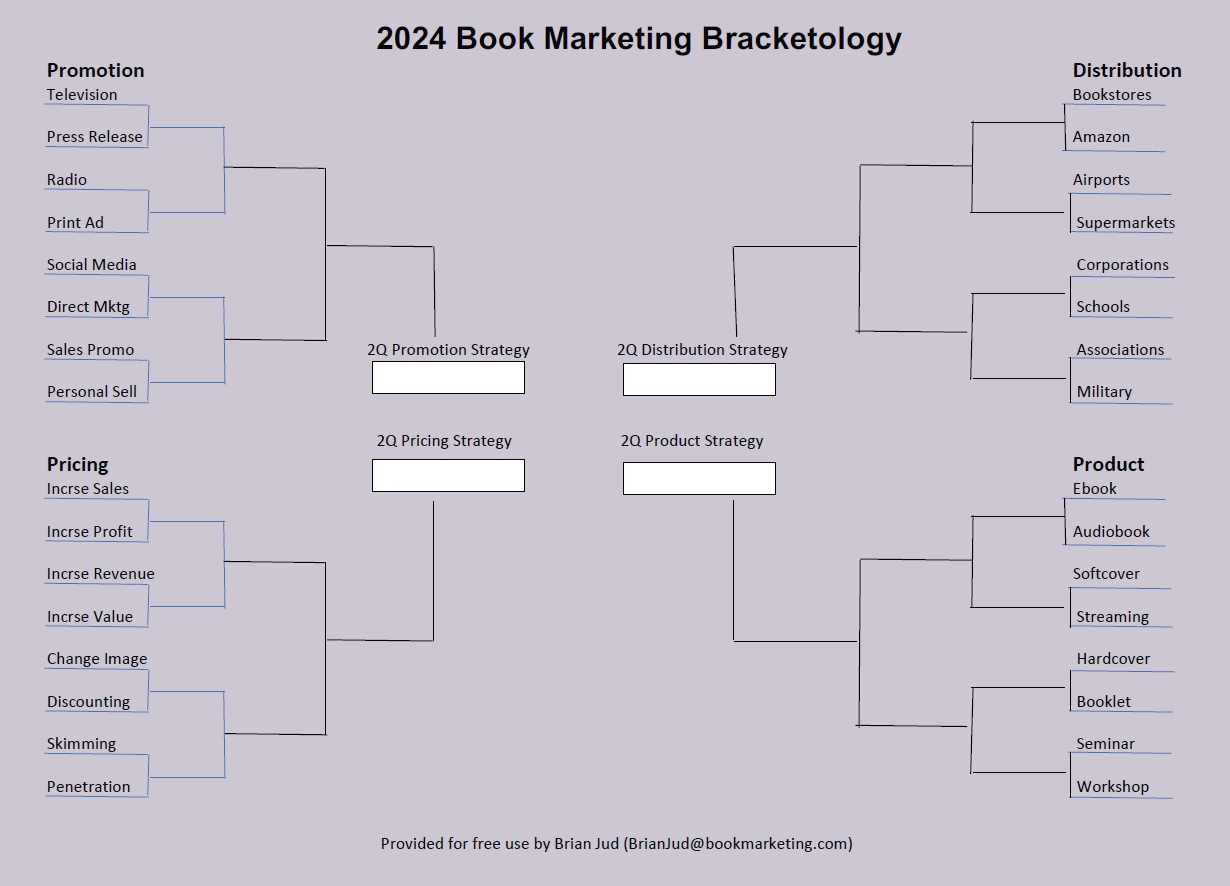Every March, basketball fans are embroiled with Madness. However, while not all of us are so captivated with basketball, and it’s technically a little past March, we are all similarly obsessed with book marketing. There are so many marketing “bracket choices” available to independent publishers and author-publishers that they become overwhelmed and do not know where to start or how to organize and implement an effective marketing mix. Until now.
Apply bracketology to book marketing by analyzing each of the four parts of a marketing mix: Promotion, Pricing, Distribution, and Product Development, as depicted here. Complete the brackets as you would for the NCAA Final Four, and, at the same time, your final marketing choices will set your Final Four marketing strategies and actions for the next three months.

Promotion
There are four major categories of Promotion: publicity, advertising, sales promotion, and personal selling. Publicity, including press releases, media appearances, and reviews, is perhaps the most economical element of the promotional mix. Advertising and direct marketing can reach many prospects simultaneously with the same message and with a relatively low cost per exposure. Sales promotion uses items such as premiums, giveaways, brochures, and coupons for generating awareness and stimulating demand through short-term awareness campaigns. Personal selling is the most persuasive selling tool because it allows two-way communication. It is the best tool for closing the sale when calling on distributors and non-retail buyers in corporations and associations. All these can be performed on- or offline. Compare the benefits of each and make your choices based on your skills, objectives and titles.
Pricing
Pricing strategies are based on your objectives. Do you want to increase your sales, revenue, or profits? Each objective requires a different strategy. If your content is priced competitively, you may want to demonstrate the unique value yours delivers, or an image you want to create or change. If you are conducting many in-person events, you may choose to set a specific price for each, perhaps depending on the venue, target, or discounting strategy. A skimming strategy sets an initial high price if you have unique content or a complex distribution chain. A penetration strategy sets a low price if your objective is to enter a competitive market or if you are selling directly to target buyers.
Distribution
Distribution strategy recognizes the need to have your products available where people shop. There are two approaches: trade (chain and niche bookstores, Amazon) and non-trade, which includes non-bookstore retailers (airport stores, supermarkets, discount stores, gift shops, etc.). You reach these through a distribution network similar to that in selling through Barnes & Noble. Also, non-trade, non-retail segments include corporations, associations, and schools as well as government and military buyers. These prospects typically purchase books in large, nonreturnable quantities. A successful distribution strategy utilizes both. For example, a children’s book could be sold through bookstores and to non-trade buyers in homeschooling, military schools, PTAs, daycare centers, children’s libraries, museums, zoos, parks, moms’ groups, toy stores, discount stores, gift shops, supermarkets, and airport stores.
Product Development
Most products, including books, are combinations of tangible and intangible elements. People do not buy the tangible features of a book (i.e., the paper and ink) that create it. They buy the content, the intangible benefits received from reading fiction: a vicarious feeling of fantasy, romance, adventure, or mystery. And when purchasing nonfiction, they are buying information, motivation, or help. Potential buyers want to purchase content in the form most useful to them. This could be a printed book, audiobook, or a corporation paying you to speak to its employees, or an association to its members. Product strategy delivers your content in the form desired by your target readers and buyers in each segment.
These brackets enable you to manipulate your marketing options until you feel comfortable with a given plan. Then, take action. Each quarter, use or change the options in the brackets found at bookmarketingworks.com/articles/2024bracketology.doc to create new alternatives as you add new tactics, segments, information, and choices. This will be a fun way to build your quarterly marketing plans, bringing you closer to your ultimate long-term objectives.